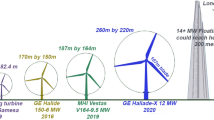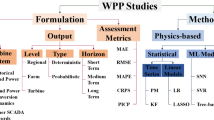Abstract
The main goal of this paper is to show the control capabilities of artificial organic networks when they are applied to variable speed wind generators. Since doubly fed induction generator (DFIG) is one of the most important variable wind generators, it requires to include advanced controllers which allow to improve its performance during operation. On the other hand, the artificial organic controllers (AOC) are intelligent controllers based on ensembles of fuzzy inference systems and artificial hydrocarbon networks. To understand AOC, this paper introduces the fundamentals of artificial hydrocarbon networks, describes the fuzzy-molecular inference ensemble, and discusses artificial organic controllers when they are deployed in variable speed wind generators. Additionally, DFIG wind turbine model is completely derived in order to test the AOC. A conventional proportional–integral–derivative (PID) controller is compared with the proposed PID-based AOC (PID-AOC) for wind generators under linear and nonlinear wind profiles. Five parameters were used for evaluation: pitch angle, stator power, rotor power, generator’s speed and power coefficient. Results showed the superior control performance in wind generators when artificial organic networks are implemented. Particularly, the PID-AOC response obtained higher values of rotor and stator powers, small pitch angle response meaning less energy consumption, high power coefficient values, and smooth starting phase minimizing risks of damage in the DFIG. The proposed PID-AOC can be applied in DFIG to minimize the undesired fluctuation on the electric grid, to reduce the mechanical stress in the blades preventing mechanical damages and to perform good sensitivity when noise in the wind is included.






















Similar content being viewed by others
References
Bianchi F, Battista H, Mantz R (2007) Wind turbine control systems: principles. Modelling and gain scheduling design, advances in industrial control. Springer, London
Biswas A, Gupta R (2009) An artificial neural network based methodology for the prediction of power and torque coefficients of a two bladed airfoil shaped H-rotor. Open Renew Energy J 2:43–51
Deng W, Chen R, He B, Liu Y, Yin L, Guo J (2012) A novel two-stage hybrid swarm intelligence optimization algorithm and application. Soft Comput 16(10):1707–1722
Dida A, Benattous D (2016) A complete modeling and simulation of DFIG based wind turbine system using fuzzy logic control. Front Energy 10(2):143–154
Ebrahimkhani S (2016) Robust fractional order sliding model control of doubly-fed induction generator (DFIG)-based wind turbines. ISA Trans 63:343–354
Ekanayake J, Holdsworth L, Wu X, Jenkins N (2003) Dynamic modeling of doubly fed induction generator wind turbines. IEEE Trans Power Syst 18(2):803–809
Fu Z, Ren J, Shu J, Sun X, Huang F (2016) Enabling personalized search over encrypted outsourced data with efficiency improvement. IEEE Trans Parallel Distrib Syst 27(9):2546–2559
Gagnon R, Sybille G, Bernard S, Pare D, Casoria S, Larose C (2005) Modeling and real-time simulation of a doubly-fed induction generator driven by a wind turbine. In: International conference on power systems transients. Montreal, Canada, pp 1–6
Goudarzi N, Zhu W (2013) A review on the development of wind turbine generators across the world. Int J Dyn Control 1(2):192–202
Gu B, Sheng VS, Tay KY, Romano W, Li S (2015) Incremental support vector learning for ordinal regression. IEEE Trans Neural Netw Learn Syst 26(7):1403–1416
Gu B, Sheng VS (2016) A robust regularization path algorithm for v-support vector classification. IEEE Trans Neural Netw Learn Syst 1–8. doi:10.1109/TNNLS.2016.2527796
Gu B, Sun X, Sheng VS (2016) Structural minimax probability machine. IEEE Trans Neural Netw Learn Syst 1–11. doi:10.1109/TNNLS.2016.2544779
Hafiz F, Abdennour A (2016) An adaptive neuro-fuzzy inertia controller for variable-speed wind turbines. Renew Energy 92:136–146
Hodzic M, Tai LC (2016) Grey predictor reference model for assisting particle swarm optimization for wind turbine control. Renew Energy 86:251–256
Holdsworth L, Wu X, Ekanayake J, Jenkins N (2003) Comparison of fixed speed and doubly-fed induction wind turbines during power system disturbances. IEE Proc Gener Transm Distrib IET 150:343–352
Karimi-Davijani H, Sheikholeslami A, Livani H, Karimi-Davijani M (2009) Fuzzy logic control of doubly-fed induction generator wind turbine. World Appl Sci J 6(4):499–508
Li S, Wang H, Tian Y, Aitouch A, Klein J (2016) Direct power control og DFIG wind turbine systems based on an intelligent proportional-integral sliding model control. ISA Trans 64:431–439
Molina A, Ponce H, Ponce P, Tello G, Ramírez M (2014) Artificial hydrocarbon networks fuzzy inference systems for CNC machines position controller. Int J Adv Manuf Technol 72(9–12):1465–1479
Munteanu I, Bratcu A, Cutululis NA, Ceanga E (2008) Optimal control of wind energy systems. Springer, Advances in Industrial Control
Ogata K (2002) Modern control engineering. Prentice Hall, Upper Saddle River
Pan Z, Zhang Y, Kwong S (2015) Efficient motion and disparity estimation optimization for low complexity multiview video coding. IEEE Trans Broadcast 61(2):166–176
Ponce P (2015) Wind generator model. Report, Tecnologico de Monterrey, Mexico City, Mexico
Ponce H, Ponce P (2011) Artificial organic networks. In: Electronics, robotics and automotive mechanics conference (CERMA), 2011 IEEE. IEEE, Cuernavaca, Morelos, Mexico, pp 29–34
Ponce P, Ramirez-Figueroa F (2010) Intelligent control systems with LabVIEW. Springer, New York
Ponce H, Ponce P, Molina A (2013) Artificial hydrocarbon networks fuzzy inference system. Math Probl Eng 2013:1–13
Ponce H, Ibarra L, Ponce P, Molina A (2014a) A novel artificial hydrocarbon networks based space vector pulse width modulation controller for induction motors. Am J Appl Sci 11(5):789–810
Ponce H, Ponce P, Molina A (2014b) Adaptive noise filtering based on artificial hydrocarbon networks: an application to audio signals. Expert Syst Appl 41(14):6512–6523
Ponce H, Ponce P, Molina A (2014c) Artificial organic networks: artificial intelligence based on carbon networks, studies in computational intelligence, vol 521. Springer, New York
Ponce H, Martinez-Villaseñor L, Miralles-Pechuan L (2015a) Comparative analysis of artificial hydrocarbon networks and data-driven approaches for human activity recognition, lecture notes in computer science, vol 9454. Springer, chap 15:150–161
Ponce H, Ponce P, Molina A (2015b) The development of an artificial organic networks toolkit for LabVIEW. J Comput Chem 36(7):478–492
Ponce H, Ponce P, Molina A (2015c) A novel robust liquid level controller for coupled-tanks systems using artificial hydrocarbon networks. Expert Syst Appl 42(22):8858–8867
Ponce H, Moya-Albor E, Brieva J (2016) A novel artificial organic controller with hermite optical flow feedback for mobile robot navigation. InTech, chap 6:145–169
Qian D, Tong S, Liu H, Liu X (2016) Load frequency control by neural-network-based integral sliding mode for nonlinear power systems with wind turbines. Neurocomputing 173:875–885
Rubio J (2014) Analytic neural network model of a wind turbine. Soft Comput 19(12):3455–3463
Wen X, Shao L, Xue Y, Fang W (2015) A rapid learning method for vehicle classification. Inf Sci 295:395–406
Xia Z, Wang X, Sun X, Liu Q, Xiong N (2016) Steganalysis of LSB matching using differences between nonadjacent pixels. Multimed Tools Appl 75(4):1947–1962
Yuhui Z, Jeon B, Danhua X, Wu QMJ, Hui Z (2015) Image segmentation by generalized hierarchical fuzzy c-means algorithm. J Intell Fuzzy Syst 28(2):961–973
Acknowledgements
The authors, Pedro Ponce and Arturo Molina, would like to thank the support from Grant No. 266632 “Bi-National Laboratory on Smart Sustainable Energy Management and Technology Training” from CONACYT.
Author information
Authors and Affiliations
Corresponding author
Ethics declarations
Conflict of interest
The authors declare that they have no conflict of interest.
Additional information
Communicated by V. Loia.
Rights and permissions
About this article
Cite this article
Ponce, P., Ponce, H. & Molina, A. Doubly fed induction generator (DFIG) wind turbine controlled by artificial organic networks. Soft Comput 22, 2867–2879 (2018). https://doi.org/10.1007/s00500-017-2537-3
Published:
Issue Date:
DOI: https://doi.org/10.1007/s00500-017-2537-3




